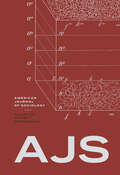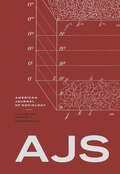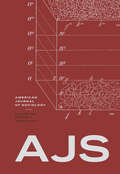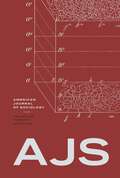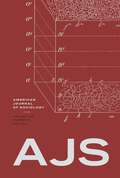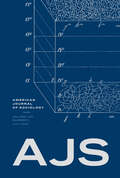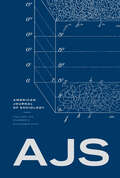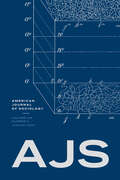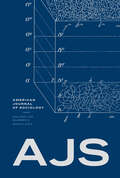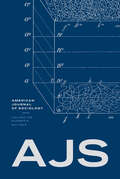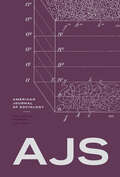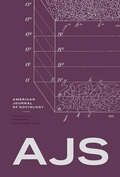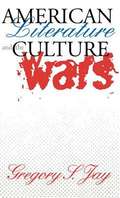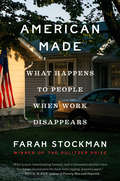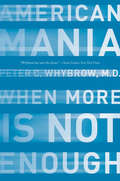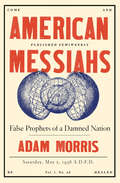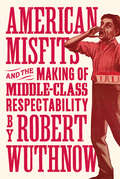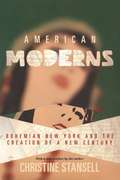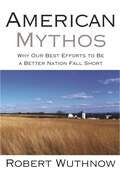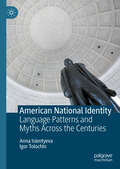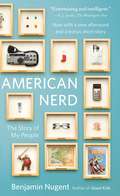- Table View
- List View
American Journal of Sociology, volume 129 number 1 (July 2023)
by American Journal of SociologyThis is volume 129 issue 1 of American Journal of Sociology. American Journal of Sociology (AJS) presents pathbreaking work from all areas of sociology, with an emphasis on theory building and innovative methods. AJS strives to speak to the general sociology reader and is open to contributions from across the social sciences—sociology, political science, economics, history, anthropology, and statistics—that seriously engage the sociological literature to forge new ways of understanding the social. AJS offers a substantial book review section that identifies the most salient work of both emerging and enduring scholars of social science. Commissioned review essays appear occasionally, offering readers a comparative, in-depth examination of prominent titles.
American Journal of Sociology, volume 129 number 2 (September 2023)
by American Journal of SociologyThis is volume 129 issue 2 of American Journal of Sociology. American Journal of Sociology (AJS) presents pathbreaking work from all areas of sociology, with an emphasis on theory building and innovative methods. AJS strives to speak to the general sociology reader and is open to contributions from across the social sciences—sociology, political science, economics, history, anthropology, and statistics—that seriously engage the sociological literature to forge new ways of understanding the social. AJS offers a substantial book review section that identifies the most salient work of both emerging and enduring scholars of social science. Commissioned review essays appear occasionally, offering readers a comparative, in-depth examination of prominent titles.
American Journal of Sociology, volume 129 number 3 (November 2023)
by American Journal of SociologyThis is volume 129 issue 3 of American Journal of Sociology. American Journal of Sociology (AJS) presents pathbreaking work from all areas of sociology, with an emphasis on theory building and innovative methods. AJS strives to speak to the general sociology reader and is open to contributions from across the social sciences—sociology, political science, economics, history, anthropology, and statistics—that seriously engage the sociological literature to forge new ways of understanding the social. AJS offers a substantial book review section that identifies the most salient work of both emerging and enduring scholars of social science. Commissioned review essays appear occasionally, offering readers a comparative, in-depth examination of prominent titles.
American Journal of Sociology, volume 129 number 4 (January 2024)
by American Journal of SociologyThis is volume 129 issue 4 of American Journal of Sociology. American Journal of Sociology (AJS) presents pathbreaking work from all areas of sociology, with an emphasis on theory building and innovative methods. AJS strives to speak to the general sociology reader and is open to contributions from across the social sciences—sociology, political science, economics, history, anthropology, and statistics—that seriously engage the sociological literature to forge new ways of understanding the social. AJS offers a substantial book review section that identifies the most salient work of both emerging and enduring scholars of social science. Commissioned review essays appear occasionally, offering readers a comparative, in-depth examination of prominent titles.
American Journal of Sociology, volume 129 number 5 (March 2024)
by American Journal of SociologyThis is volume 129 issue 5 of American Journal of Sociology. American Journal of Sociology (AJS) presents pathbreaking work from all areas of sociology, with an emphasis on theory building and innovative methods. AJS strives to speak to the general sociology reader and is open to contributions from across the social sciences—sociology, political science, economics, history, anthropology, and statistics—that seriously engage the sociological literature to forge new ways of understanding the social. AJS offers a substantial book review section that identifies the most salient work of both emerging and enduring scholars of social science. Commissioned review essays appear occasionally, offering readers a comparative, in-depth examination of prominent titles.
American Journal of Sociology, volume 129 number 6 (May 2024)
by American Journal of SociologyThis is volume 129 issue 6 of American Journal of Sociology. American Journal of Sociology (AJS) presents pathbreaking work from all areas of sociology, with an emphasis on theory building and innovative methods. AJS strives to speak to the general sociology reader and is open to contributions from across the social sciences—sociology, political science, economics, history, anthropology, and statistics—that seriously engage the sociological literature to forge new ways of understanding the social. AJS offers a substantial book review section that identifies the most salient work of both emerging and enduring scholars of social science. Commissioned review essays appear occasionally, offering readers a comparative, in-depth examination of prominent titles.
American Journal of Sociology, volume 130 number 1 (July 2024)
by American Journal of SociologyThis is volume 130 issue 1 of American Journal of Sociology. American Journal of Sociology (AJS) presents pathbreaking work from all areas of sociology, with an emphasis on theory building and innovative methods. AJS strives to speak to the general sociology reader and is open to contributions from across the social sciences—sociology, political science, economics, history, anthropology, and statistics—that seriously engage the sociological literature to forge new ways of understanding the social. AJS offers a substantial book review section that identifies the most salient work of both emerging and enduring scholars of social science. Commissioned review essays appear occasionally, offering readers a comparative, in-depth examination of prominent titles.
American Journal of Sociology, volume 130 number 2 (September 2024)
by American Journal of SociologyThis is volume 130 issue 2 of American Journal of Sociology. American Journal of Sociology (AJS) presents pathbreaking work from all areas of sociology, with an emphasis on theory building and innovative methods. AJS strives to speak to the general sociology reader and is open to contributions from across the social sciences—sociology, political science, economics, history, anthropology, and statistics—that seriously engage the sociological literature to forge new ways of understanding the social. AJS offers a substantial book review section that identifies the most salient work of both emerging and enduring scholars of social science. Commissioned review essays appear occasionally, offering readers a comparative, in-depth examination of prominent titles.
American Journal of Sociology, volume 130 number 3 (November 2024)
by American Journal of SociologyThis is volume 130 issue 3 of American Journal of Sociology. American Journal of Sociology (AJS) presents pathbreaking work from all areas of sociology, with an emphasis on theory building and innovative methods. AJS strives to speak to the general sociology reader and is open to contributions from across the social sciences—sociology, political science, economics, history, anthropology, and statistics—that seriously engage the sociological literature to forge new ways of understanding the social. AJS offers a substantial book review section that identifies the most salient work of both emerging and enduring scholars of social science. Commissioned review essays appear occasionally, offering readers a comparative, in-depth examination of prominent titles.
American Journal of Sociology, volume 130 number 4 (January 2025)
by American Journal of SociologyThis is volume 130 issue 4 of American Journal of Sociology. American Journal of Sociology (AJS) presents pathbreaking work from all areas of sociology, with an emphasis on theory building and innovative methods. AJS strives to speak to the general sociology reader and is open to contributions from across the social sciences—sociology, political science, economics, history, anthropology, and statistics—that seriously engage the sociological literature to forge new ways of understanding the social. AJS offers a substantial book review section that identifies the most salient work of both emerging and enduring scholars of social science. Commissioned review essays appear occasionally, offering readers a comparative, in-depth examination of prominent titles.
American Journal of Sociology, volume 130 number 5 (March 2025)
by American Journal of SociologyThis is volume 130 issue 5 of American Journal of Sociology. American Journal of Sociology (AJS) presents pathbreaking work from all areas of sociology, with an emphasis on theory building and innovative methods. AJS strives to speak to the general sociology reader and is open to contributions from across the social sciences—sociology, political science, economics, history, anthropology, and statistics—that seriously engage the sociological literature to forge new ways of understanding the social. AJS offers a substantial book review section that identifies the most salient work of both emerging and enduring scholars of social science. Commissioned review essays appear occasionally, offering readers a comparative, in-depth examination of prominent titles.
American Journal of Sociology, volume 130 number 6 (May 2025)
by American Journal of SociologyThis is volume 130 issue 6 of American Journal of Sociology. American Journal of Sociology (AJS) presents pathbreaking work from all areas of sociology, with an emphasis on theory building and innovative methods. AJS strives to speak to the general sociology reader and is open to contributions from across the social sciences—sociology, political science, economics, history, anthropology, and statistics—that seriously engage the sociological literature to forge new ways of understanding the social. AJS offers a substantial book review section that identifies the most salient work of both emerging and enduring scholars of social science. Commissioned review essays appear occasionally, offering readers a comparative, in-depth examination of prominent titles.
American Journal of Sociology, volume 131 number 1 (July 2025)
by American Journal of SociologyThis is volume 131 issue 1 of American Journal of Sociology. American Journal of Sociology (AJS) presents pathbreaking work from all areas of sociology, with an emphasis on theory building and innovative methods. AJS strives to speak to the general sociology reader and is open to contributions from across the social sciences—sociology, political science, economics, history, anthropology, and statistics—that seriously engage the sociological literature to forge new ways of understanding the social. AJS offers a substantial book review section that identifies the most salient work of both emerging and enduring scholars of social science. Commissioned review essays appear occasionally, offering readers a comparative, in-depth examination of prominent titles.
American Journal of Sociology, volume 131 number 2 (September 2025)
by American Journal of SociologyThis is volume 131 issue 2 of American Journal of Sociology. American Journal of Sociology (AJS) presents pathbreaking work from all areas of sociology, with an emphasis on theory building and innovative methods. AJS strives to speak to the general sociology reader and is open to contributions from across the social sciences—sociology, political science, economics, history, anthropology, and statistics—that seriously engage the sociological literature to forge new ways of understanding the social. AJS offers a substantial book review section that identifies the most salient work of both emerging and enduring scholars of social science. Commissioned review essays appear occasionally, offering readers a comparative, in-depth examination of prominent titles.
American Literature and the Culture Wars
by Gregory S. JayIn this book the author states that he will be: "...questioning both the scope and the purpose of American literary studies. What ends do we pursue in the study and teaching of an "American" literature? Has the idea of a canon of great books reached the end of its usefulness? Where does American literature end and Mexican or Caribbean or Canadian or postcolonial literature begin? Is multiculturalism the end of civilization as we know it or the start of an overdue regeneration of our politics and pedagogy? How has the political economy of making ends meet in an era of downsizing and privatization affected academic freedom and the course of academic study? What happens in the classroom when we try to put an end to the conventional ways in which we have conceived and taught our subject? Playing off the pun in the title of this introduction, then, I want to explore this set of questions about the "ends" of American literary studies. This exploration includes rethinking our ends both in the nominal sense of "pragmatic intention" (goal, aim, objective, design, scheme) and in the verbal sense of "reaching a conclusion" (limit, terminate, cease, halt, expire). By focusing attention on these many ends and the controversial issues they involve, I hope in part to explain how this once arcane academic discipline ended up at the center of the culture wars."
American Made: What Happens to People When Work Disappears
by Farah StockmanWhat happens when Americans lose their jobs? In this illuminating story of ruin and reinvention, Pulitzer Prize-winning journalist Farah Stockman gives an up-close look at the profound role work plays in our sense of identity and belonging, as she follows three workers whose lives unravel when the factory they have dedicated so much to closes down. &“With humor, breathtaking honesty, and a historian&’s satellite view, Stockman illuminates the fault lines ripping America apart.&”—Beth Macy, author of Factory Man and DopesickShannon, Wally, and John built their lives around their place of work. Shannon, a white single mother, became the first woman to run the dangerous furnaces at the Rexnord manufacturing plant in Indianapolis, Indiana, and was proud of producing one of the world&’s top brands of steel bearings. Wally, a black man known for his initiative and kindness, was promoted to chairman of efficiency, one of the most coveted posts on the factory floor, and dreamed of starting his own barbecue business one day. John, a white machine operator, came from a multigenerational union family and clashed with a work environment that was increasingly hostile to organized labor.The Rexnord factory had served as one of the economic engines for the surrounding community. When it closed, hundreds of people lost their jobs. What had life been like for Shannon, Wally, and John, before the plant shut down? And what became of them after the jobs moved to Mexico and Texas? American Made is the story of a community struggling to reinvent itself. It is also a story about race, class, and American values, and how jobs serve as a bedrock of people&’s lives and drive powerful social justice movements. This revealing book shines a light on a crucial political moment, when joblessness and anxiety about the future of work have made themselves heard at a national level. Most of all, it is a story about people: who we consider to be one of us and how the dignity of work lies at the heart of who we are.
American Mania: When More is Not Enough
by Peter C. WhybrowA doctor's bold analysis of the cultural disease that afflicts us all. Despite an astonishing appetite for life, more and more Americans are feeling overworked and dissatisfied. In the world's most affluent nation, epidemic rates of stress, anxiety, depression, obesity, and time urgency are now grudgingly accepted as part of everyday existence they signal the American Dream gone awry. Peter C. Whybrow, director of the Neuropsychiatric Institute at UCLA, grounds the extraordinary achievements and excessive consumption of the American nation in an understanding of the biology of the brain's reward system offering for the first time a comprehensive and physical explanation for the addictive mania of consumerism. American Mania presents a clear and novel vantage point from which to understand the most pressing social issues of our time, while offering an informed approach to refocusing our pursuit of happiness. Drawing upon rich scientific case studies and colorful portraits, "this fascinating and important book will change the way you think about American life" (Karen Olson, Utne Reader).
American Messiahs: False Prophets Of A Damned Nation
by Adam MorrisA history with sweeping implications, American Messiahs challenges our previous misconceptions about “cult” leaders and their messianic power. Mania surrounding messianic prophets has defined the national consciousness since the American Revolution. From Civil War veteran and virulent anticapitalist Cyrus Teed, to the dapper and overlooked civil rights pioneer Father Divine, to even the megalomaniacal Jim Jones, these figures have routinely been dismissed as dangerous and hysterical outliers. After years of studying these emblematic figures, Adam Morris demonstrates that messiahs are not just a classic trope of our national culture; their visions are essential for understanding American history. As Morris demonstrates, these charismatic, if flawed, would-be prophets sought to expose and ameliorate deep social ills—such as income inequality, gender conformity, and racial injustice. Provocative and long overdue, this is the story of those who tried to point the way toward an impossible “American Dream”: men and women who momentarily captured the imagination of a nation always searching for salvation.
American Military Life In The 21st Century: Social, Cultural, And Economic Issues And Trends
by Eugenia Weiss Carl CastroAmerican Military Life in the 21st Century <P><P> Social, Cultural, and Economic Issues and Trends <P><P> VOLUME I: Active Duty Life
American Military Life In The 21st Century: Social, Cultural, And Economic Issues And Trends
by Eugenia Weiss Carl CastroAmerican Military Life in the 21st Century <P><P> Social, Cultural, and Economic Issues and Trends <P><P> VOLUME 2: Life of Military Families, National Guardsmen and Reservists, and Veterans
American Misfits and the Making of Middle-Class Respectability
by Robert WuthnowHow American respectability has been built by maligning those who don't make the gradeHow did Americans come to think of themselves as respectable members of the middle class? Was it just by earning a decent living? Or did it require something more? And if it did, what can we learn that may still apply?The quest for middle-class respectability in nineteenth-century America is usually described as a process of inculcating positive values such as honesty, hard work, independence, and cultural refinement. But clergy, educators, and community leaders also defined respectability negatively, by maligning individuals and groups—“misfits”—who deviated from accepted norms.Robert Wuthnow argues that respectability is constructed by “othering” people who do not fit into easily recognizable, socially approved categories. He demonstrates this through an in-depth examination of a wide variety of individuals and groups that became objects of derision. We meet a disabled Civil War veteran who worked as a huckster on the edges of the frontier, the wife of a lunatic who raised her family while her husband was institutionalized, an immigrant religious community accused of sedition, and a wealthy scion charged with profiteering.Unlike respected Americans who marched confidently toward worldly and heavenly success, such misfits were usually ignored in paeans about the nation. But they played an important part in the cultural work that made America, and their story is essential for understanding the “othering” that remains so much a part of American culture and politics today.
American Moderns: Bohemian New York and the Creation of a New Century
by Christine StansellIn the early twentieth century, an exuberant brand of gifted men and women moved to New York City, not to get rich but to participate in a cultural revolution. For them, the city's immigrant neighborhoods--home to art, poetry, cafes, and cabarets in the European tradition--provided a place where the fancies and forms of a new America could be tested. Some called themselves Bohemians, some members of the avant-garde, but all took pleasure in the exotic, new, and forbidden. In American Moderns, Christine Stansell tells the story of the most famous of these neighborhoods, Greenwich Village, which--thanks to cultural icons such as Eugene O'Neill, Isadora Duncan, and Emma Goldman--became a symbol of social and intellectual freedom. Stansell eloquently explains how the mixing of old and new worlds, politics and art, and radicalism and commerce so characteristic of New York shaped the modern American urban scene. American Moderns is both an examination and a celebration of a way of life that's been nearly forgotten.
American Mythos: Why Our Best Efforts to Be a Better Nation Fall Short
by Robert WuthnowAmerica was built on stories: tales of grateful immigrants arriving at Ellis Island, Horatio Alger-style transformations, self-made men, and the Protestant work ethic. In this new book, renowned sociologist Robert Wuthnow examines these most American of stories--narratives about individualism, immigration, success, religion, and ethnicity--through the eyes of recent immigrants. In doing so, he demonstrates how the "American mythos" has both legitimized American society and prevented it from fully realizing its ideals. This magisterial work is a reflection and meditation on the national consciousness. It details how Americans have traditionally relied on narratives to address what it means to be strong, morally responsible individuals and to explain why some people are more successful than others--in short, to help us make sense of our lives. But it argues that these narratives have done little to help us confront new challenges. We pass laws to end racial discrimination, yet lack the resolve to create a more equitable society. We welcome the idea of pluralism in religion and values, yet we are shaken by the difficulties immigration presents. We champion prosperity for all, but live in a country where families are still homeless. American Mythos aptly documents this disconnect between the stories we tell and the reality we face. Examining how cultural narratives may not, and often do not, reflect the reality of today's society, it challenges readers to become more reflective about what it means to live up to the American ideal.
American National Identity: Language Patterns and Myths Across the Centuries
by Anna Islentyeva Igor TolochinThis book offers an analytical tool for identifying and analysing the linguistic mechanisms that shape American national identity in public discourses. Drawing on methods from (critical) discourse analysis and corpus linguistics, the authors provide insights into various levels of discourse structures, consider the social and political climate of the US at different stages of its history, trace the diachronic development of the linguistic patterns that shape the American national identity, and conduct a thorough discursive analysis of seminal texts such as The Declaration of Independence and the Preamble to the US Constitution. This book defines the key linguistic markers of the American national identity and provides an insight into how these markers are used to promote various ideologies in the pluralistic world of the contemporary USA. This monograph will be of interest to students and scholars working in fields such as Applied Linguistics, (Critical) Discourse Studies, Cultural Studies, US History and Politics.
American Nerd: The Story of My People
by Benjamin NugentMost people know a nerd when they see one but can't define just what a nerd is. American Nerd: The Story of My People gives us the history of the concept of nerdiness and of the subcultures we consider nerdy. What makes Dr. Frankenstein the archetypal nerd? Where did the modern jock come from? When and how did being a self-described nerd become trendy? As the nerd emerged, vaguely formed, in the nineteenth century, and popped up again and again in college humor journals and sketch comedy, our culture obsessed over the designation. Mixing research and reportage with autobiography, critically acclaimed writer Benjamin Nugent embarks on a fact-finding mission of the most entertaining variety. He seeks the best definition of nerd and illuminates the common ground between nerd subcultures that might seem unrelated: high-school debate team kids and ham radio enthusiasts, medieval reenactors and pro-circuit Halo players. Why do the same people who like to work with computers also enjoy playing Dungeons & Dragons? How are those activities similar? This clever, enlightening book will appeal to the nerd (and antinerd) that lives inside all of us.

